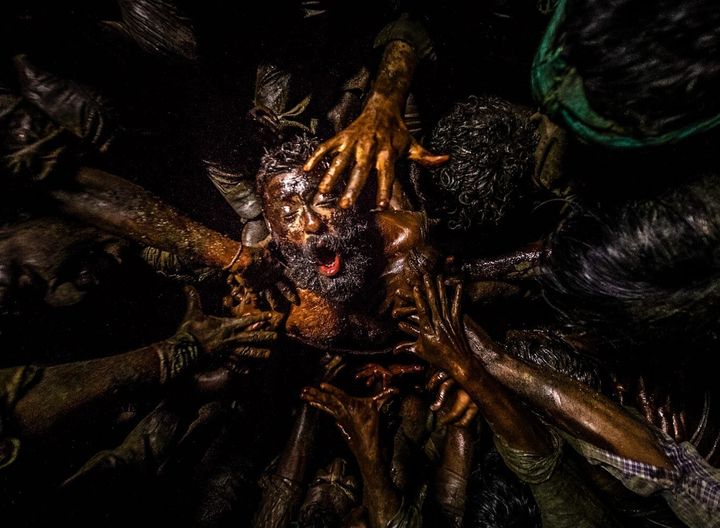
From the moment images unfold on screen, one is caught by the film’s atmosphere of visceral, heaving urgency. Right from how the men and women are introduced to their vicarious fascination for meat and beast, to containing the raw energy, greed and ego of mankind on screen, Jallikattu is almost an out-of-body experience.
Jallikattu is a set in a village somewhere in South Kerala, where a typical Sunday morning begins with a visit to the local butcher. Varkey (Chemban Vinod) with a metaphorical “Kaalan” added to his name seems to enjoy the process of procuring meat—picking the beast, dragging a rope through its nose to slicing and segregating it into spine, ribs, cutlets and even an extra helping of juicy liver to a favourite customer. At the local Church you see Church goers hanging black plastic meat bags on a tree. When Varkey’s shop assistant Varghese (Antony Varghese) delivers these bags to homes, the reactions are witty—a Hindu man shudders at the sight of the raw meat but is quick to remind his wife to “season it abundantly with pepper.” At times the villagers remind you of the ones you have seen in Angamaly Diaries, like Pellissery picked them right from the village, males high on testosterone and women who fight, cook and love with abandon and co-incidentally retaining their obsession for red meat, blood and gore. And the animals are all snorting and grunting in the backdrop, perhaps at the realisation that their primal instincts are still no match for the human beings.
For the latest news and more, follow HuffPost India on Twitter, Facebook, and subscribe to our newsletter.
Jallikattu, adapted from Hareesh S’ book, isn’t really about well-defined characters. There aren’t many characters in the film, yet the screen is bursting with people. The story thread is fairly simple, like an Aesop’s fable—a rogue buffalo (flawlessly done VFX) is let loose in the village and the villagers are on the run to hunt it down. True, the title borrows its name from the traditional bull-taming event in Tamil Nadu, but the film has nothing to do with the sport. It only adds its own layers to this indigenous tradition or the race of man versus the wild.
The narrative, like the buffalo on the loose, keeps a tight rein on its pace. When events start to tense up, you get brilliant little reliefs. An organic farmer with a saintly disposition finds himself going ballistic when he realises that the bull has plundered his vegetation. What perceptibly appears to be a string of expletives coming from his mouth are hilariously muted, prompting the otherwise temperamental Varkey to calm him down. A wedding is being planned, and typically the entire focus is on the menu—instructions have been given to the local caterer for appams, pork curry glistening in ghee, and beef roast laden with pieces of coconut shaped like the half-moon. But with the bull out in the open, meat supply might hit a roadblock prompting the father to visit the local chicken supplier at night, resulting in another set of hysterical events. For the villagers, chicken is an inferior option and any celebration can only mean a special rib cut cooked in Tapioca.
Like every Lijo film, women get little screen time, but they are all no-nonsense, proactive women who seem content to stay within the patriarchal familial system. Here there is Varkey’s sister—a source of gossip for the villagers due to a failed attempt at eloping—who Varghese is in love with. But one felt she was stitched from the same cloth as the women in Angamaly Diaries.
Varghese appears to be an orphan but there is more to him than his shy smile, the viewer gradually realised. So, when they introduce a man to kill the bull, the lines are rapidly getting hazy between him and Varghese, as both of them are in this for selfish gains. Varkey’s role never stretches beyond his occupation, often ending up a tired onlooker.
Just when we wonder at the absurdity of it all (how difficult is it to capture a bull?), it’s how organically Lijo swings the power play that takes the mickey out of you. What is evidently a wild goose chase soon becomes a man versus beast dynamic. The boundaries will begin to get blurry; the man’s grunts and snorts uncannily matches the beast’s and in quick succession the man turns into a predator and the beast no longer wants to fight him.
While the soundscape is spectacular, merging the fear and anxiety of the man and the bull, the frames (Gireesh Gangadharan) are incredibly lifelike, as if conceived by an unrestrained imagination. The night shot captures the brutality and fear of darkness, with the beast tailing the man, and the tiny fire lamps lend a stunning contrast, especially in aerial views.
The climax is a fitting closure to the intense race, making us introspect about our own humanness. All of a sudden, animal instinct becomes an ambiguous phrase.